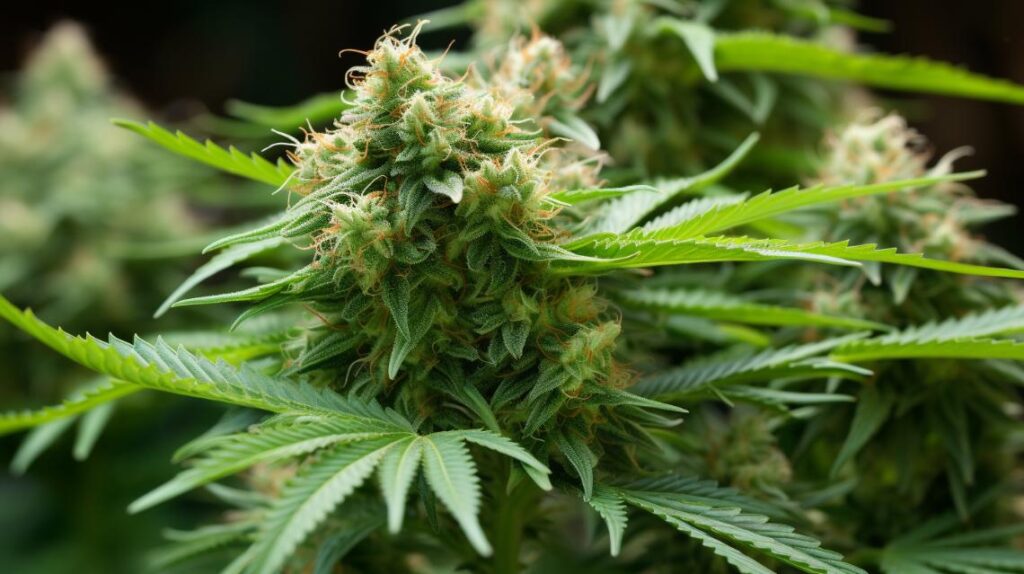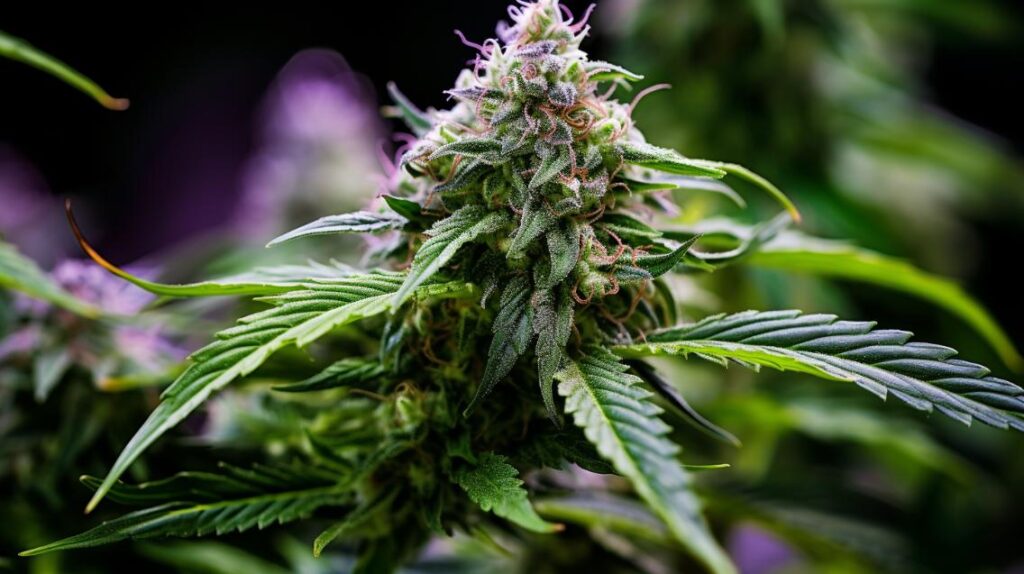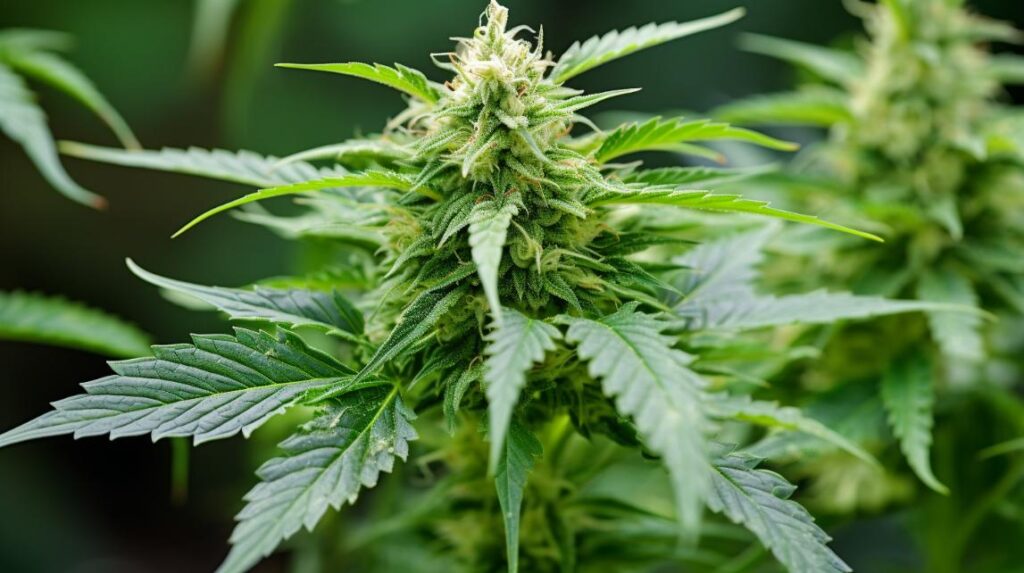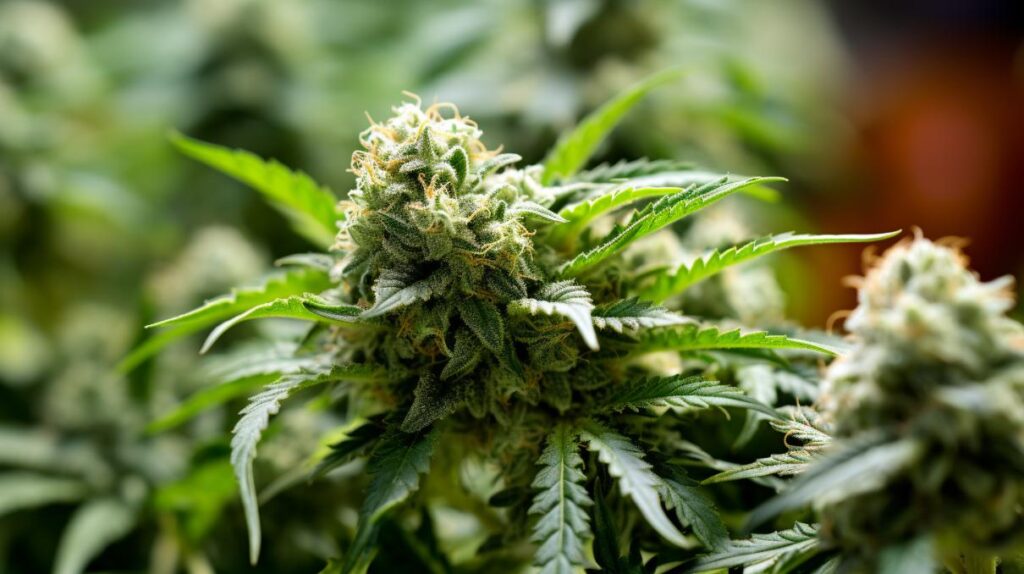Huckleberry

The Huckleberry strain, a notable indica-dominant hybrid developed by Dynasty Seeds, merges the robust genetic lineage of Oregon Afghani with Oregon Huckleberry, resulting in a blend that captivates both recreational and medical users with its high THC levels and distinct fruity aroma. Known for its therapeutic efficacy, particularly in stress and pain management, Huckleberry raises intriguing questions about its broader implications for wellness and relaxation practices. As this strain continues to gain popularity, further exploration into its diverse applications and potential benefits could provide valuable insights into its role within the evolving cannabis landscape.
Key Takeaways
- Huckleberry Kush is a mostly indica strain with a genetic lineage from Oregon Afghani and Oregon Huckleberry.
- Features a high THC content ranging from 20% to 26%, with minimal CBD.
- Known for its fruity aroma with sweet citrus and kush notes, enhancing sensory experiences.
- Effective for medical use, addressing conditions like chronic pain and anxiety without sedative effects.
- Requires about 8 weeks of flowering time and is suitable for indoor growing, producing dense buds and high resin content.
Genetic Lineage
The genetic lineage of Huckleberry Kush traces back to a robust cross between an Oregon Afghani clone from the early 1980s and an Oregon Huckleberry male, meticulously bred by Dynasty Seeds. This strategic hybridization focuses on enhancing the phenotypic traits and stabilizing the genetic characteristics of the Huckleberry Kush strain. Dynasty Seeds, renowned for their precision in strain development, selected these parent strains to combine the resilience and potent resin production typical of the Oregon Afghani with the unique flavor profile and coloration of the Oregon Huckleberry.
The result of this careful breeding is a mostly indica strain that exhibits hardy growth patterns and produces exceptionally dense buds. These dense buds are a hallmark of the strain, contributing to its robust structure and playing a significant role in its cultivation practices. Cultivators value Huckleberry Kush for its manageable flowering time, typically around 8 weeks when grown indoors, and its adaptability to both soil and hydroponic setups.
Focusing on these key attributes allows growers to optimize conditions and achieve a high yield of quality product. The dense bud structure also plays an important role in the strain’s overall THC/CBD content profile, impacting its potency and therapeutic potential.
THC/CBD Content
Huckleberry Kush’s THC content, which typically ranges from 20% to 26%, categorizes it as a highly potent strain suitable for experienced users. The high THC content underscores its robust potency, positioning it as a favorite among those seeking intense psychoactive effects. This strain’s hybrid nature contributes to a balanced yet powerful experience, likely due to the strategic breeding of its parent strains.
In contrast, the CBD content in Huckleberry Kush is negligible, often around 0%. This minimal presence of CBD further highlights the strain’s focus on delivering a potent THC-driven experience rather than a balanced THC/CBD profile. Such a composition makes it less ideal for those seeking the therapeutic benefits typically associated with higher CBD levels.
Further analysis of Huckleberry Kush reveals variability in its potency across different phenotypes. Some phenotypes reach the upper edge of its THC spectrum at 26%, amplifying both the psychoactive and therapeutic effects. This variance emphasizes the importance of selective breeding and phenotype selection in cultivation practices to achieve desired potency levels. Cultivators and consumers alike should note these variations when considering Huckleberry Kush for cultivation or consumption, ensuring alignment with their potency preferences and experience levels.
Terpene Profile
Understanding the terpene profile of Huckleberry Kush is essential for cultivators aiming to maximize the aromatic appeal and flavor characteristics of this strain. The primary terpenes in Huckleberry emanate an intense fruity aroma that is distinctly marked by notes of sweet citrus and kush, contributing to a complex olfactory experience. This strain, derived from a cross of Honey Boo and True Tangie, showcases a rich, marmalade-like scent that resonates well with both connoisseurs and casual users, enhancing its marketability.
For cultivators, focusing on the ideal development of these terpenes involves maintaining precise environmental conditions throughout the 65-70 day flowering period. Temperature and humidity control are vital, as these factors directly influence terpene synthesis and retention. Advanced techniques such as the careful manipulation of light exposure can also play a significant role in amplifying the terpene profile, particularly the levels of myrcene and limonene, which are pivotal in producing the kush and citrus notes.
Strategic curing processes further intensify these aromas, ensuring that the buds of Huckleberry Kush maintain their potent, aromatic quality. Cultivators aiming for premium quality production will find mastering these elements indispensable in distinguishing their Huckleberry Kush in competitive markets.
Effects
Exploring the effects of the Huckleberry strain reveals its considerable impact on inducing hunger, happiness, and euphoria among users. With a THC content ranging from 15% to 24%, the potent effects of this strain are not just anecdotal but are backed by its robust cannabinoid profile. The strain’s unique terpene blend contributes to its distinctive berry smell, enhancing the overall sensory experience and potentially influencing its psychoactive effects.
The effects of the Huckleberry strain can be outlined as follows:
- Appetite Stimulation: The strain is widely recognized for its ability to induce hunger, making it a favorite among those who seek to increase their appetite.
- Euphoric Sensation: Users often report a strong sense of happiness and euphoria, attributed to the strain’s high THC levels.
- Stress Relief: Its calming properties help in reducing stress levels, providing a soothing effect that is highly valued in high-pressure situations.
- Aroma Impact: The intense berry smell not only makes this strain appealing but also enhances the overall consumption experience, linking olfactory stimuli with therapeutic benefits.
This detailed insight into the Huckleberry strain’s effects underlines its multifaceted benefits and its particular suitability for users seeking both recreational and stress-relief outcomes.
Medical Uses
The medical applications of the Huckleberry strain are varied, addressing conditions ranging from chronic pain and anxiety to more specific ailments such as multiple sclerosis and cancer. This strain’s efficacy in pain relief is particularly noted, offering a significant reduction in discomfort without the sedative effects often associated with other analgesic strains. Its ability to induce an uplifting and euphoric state aids in mitigating the psychological challenges linked to chronic conditions, enhancing both focus and clear-headedness.
Moreover, Huckleberry’s capacity for stress relief is rooted in its unique phytochemical profile, which provides energizing effects that help maintain alertness. This is particularly beneficial for patients dealing with anxiety and stress-related disorders, who require relief without the lethargy that can hinder daily activities. The therapeutic benefits are supported by the strain’s cultivation characteristics; known for moderate to heavy yields, Huckleberry is a viable option for both small-scale personal and larger commercial cultivation efforts aimed at sustainable production of medical cannabis.
The intense fruity smell of the strain also plays a subtle role in its therapeutic use, offering a sensory experience that may enhance the overall efficacy of its medical applications, providing a holistic approach to symptom management.
Flavor and Aroma
Huckleberry strain’s intense fruity aroma, characterized by pungent notes of sweet citrus and kush, contributes greatly to its popularity among both consumers and cultivators. This distinctive aroma profile is further enriched by the underlying berry-like nuances that are reminiscent of a lush, ripe blueberry field. The complexity of its aroma makes it particularly appealing in the cultivation market, where scent profiles play a pivotal role in the commercial success of a strain.
The flavor profile of the Huckleberry strain is equally alluring, marked by:
- Sweet Blueberry Notes: A dominant, invigorating taste that lingers on the palate, mirroring the aroma’s berry characteristics.
- Kush Undertones: A classic, earthy kush flavor that provides a robust foundation to the fruity overtones.
- Citrus Highlights: These zesty notes add a sharpness that enhances the overall sensory experience, making each inhalation a multi-layered discovery.
- Marmalade-Like Sweetness: This unique aspect resembles the sweet, tangy flavor of orange marmalade, enriching the complexity of the strain.
Such a rich amalgamation of flavors and aromas not only underscores the genetic craftsmanship behind Huckleberry but also highlights its appeal in a competitive marketplace focused on distinctive and memorable cannabis experiences.
Appearance
Building on its sensory appeal, the Huckleberry weed strain presents visually striking characteristics that further enhance its marketability. The strain boasts compact light green flowers that exhibit a vibrant contrast with prominent orange pistils. These buds are not only dense but also sticky, indicating a rich trichome coverage that is essential for both aesthetic appeal and cannabinoid production.
The trichomes on Huckleberry buds are a clear indicator of potency and are often used as a metric of quality within the industry. The resinous texture derived from these trichomes makes the buds particularly appealing under retail display lighting, enhancing their visual appeal and hinting at the potent aroma and taste profile. The strain’s distinct berry aroma, coupled with its sweet aftertaste, is visually complemented by small to medium-sized buds interspersed with enticing purple patches. This coloration adds a unique visual dimension that aligns well with the expectations set by its aromatic profile.
The appearance of Huckleberry is indicative of its well-balanced hybrid nature and the careful cultivation practices needed to achieve such quality. The blend of THC content, ranging from 8% to 26%, and the visually appealing trichome coverage, positions this strain as a top choice for both connoisseurs and casual consumers alike.
Grow Information
Cultivation of Huckleberry Kush, a mostly indica strain, requires approximately eight weeks of flowering when grown indoors. This strain, developed by Dynasty Seeds, is notable for its robust resin profile and structural characteristics typical of Kush varieties. As cultivators aim for ideal yield and quality, understanding the specific requirements of Huckleberry Kush is essential.
Here are key cultivation insights for Huckleberry Kush:
-
Genetic Background: Originating from an Oregon Afghani clone from the early ’80s, Huckleberry Kush maintains a kush pole plant structure. This heritage contributes to its resilience and distinct growth patterns.
-
Flowering Time: Consistent with its indica lineage, Huckleberry Kush completes its flowering cycle in 8 weeks. Timely observations during this phase are important to prevent over-ripening.
-
Bud Structure: Expect dense buds that are typical of indica strains. These dense clusters not only enhance the visual appeal but also indicate a high concentration of cannabinoids.
-
Resin Production: The strain is characterized by a copious resin content, making it an excellent choice for extract production. This trait should be a focal point in cultivation strategy to maximize resin yield.
These cultivation properties make Huckleberry Kush a rewarding endeavor for experienced growers seeking a high-quality indica strain with significant resin production.
Adverse Effects
While exploring the Huckleberry strain, users often report encountering adverse effects such as dry eyes, dry mouth, and occasional headaches. These side effects, though important in the consumption of various cannabis strains, appear prominently enough amongst Huckleberry users to merit attention.
The symptoms such as dry eyes and dry mouth are attributed to the strain’s cannabinoid profile, which influences the body’s submandibular glands responsible for saliva production, thereby reducing moisture in both the eyes and mouth. Headaches, on the other hand, could be induced by various factors including but not limited to dehydration from reduced saliva production or from the strain’s potent effects.
For a clearer understanding, below is a table summarizing these common adverse effects:
| Effect | Frequency | Possible Cause |
|---|---|---|
| Dry Eyes | Very Common | Dehydration/Cannabinoid effect |
| Dry Mouth | Very Common | Reduction in saliva production |
| Headaches | Less Common | Potency/Dehydration |
Industry insights suggest that understanding these adverse effects is important for both consumers and cultivators. Cultivators might seek to develop strains that mitigate these undesirable traits, enhancing user experience and broadening the appeal of the Huckleberry strain.
Comparisons with Similar Strains
Analyzing the Huckleberry strain in comparison to similar strains reveals significant differences in cultivation requirements and cannabinoid profiles. Huckleberry Kush, a mostly indica strain, is distinct in its cultivation complexity and the unique benefits it offers particularly in medical applications due to its high CBD content.
Here’s a breakdown of Huckleberry Kush attributes compared to similar strains:
- Flowering Time: Huckleberry Kush requires approximately 56 days to flower indoors, which is relatively shorter compared to some other high CBD indica strains that might extend beyond 60 days.
- Cannabinoid Profile: This strain is known not just for its high THC levels but also for its significant CBD content, making it highly valued for its medical value.
- Plant Structure and Bud Density: Exhibiting a typical kush pole plant structure, Huckleberry Kush produces significantly dense buds, which is a sought-after trait for both cultivation efficiency and product quality.
- Phenotypic Variation: It offers a variety of phenotypes with differences in smell, taste, yield, and vegetative time, providing flexibility and customization options for cultivators and breeders aiming to optimize specific traits.
These aspects underscore the unique positioning of Huckleberry Kush within the cannabis cultivation industry, highlighting its particular suitability for medical use and cultivation adaptability.
Research and Studies
Recent studies on the Huckleberry weed strain highlight its potential therapeutic benefits, particularly in mood regulation and cognitive enhancement. Clinical trials underscore its efficacy in treating mood disorders such as anxiety and depression, due to its capacity to provide an uplifting and euphoric experience without inducing lethargy. This makes it particularly well-suited for daytime use, allowing patients to maintain productivity and social engagement.
The distinctive cannabinoid profile of Huckleberry contributes to its unique effects. Research indicates that its rich terpene blend not only enhances mood but also provides effective pain relief, a significant finding for those suffering from chronic pain conditions. The strain’s ability to improve focus and clear-headedness can be attributed to its balanced THC and CBD content, which synergistically work to alleviate symptoms of hyperactivity and migraines without the common side effects associated with conventional medications.
Furthermore, scientific studies suggest that the Huckleberry strain aids in managing stress and anxiety, enhancing overall wellbeing. Its non-sedative qualities are particularly advantageous for patients seeking alternatives to traditional treatments that do not compromise their day-to-day functionality. This strain exemplifies the potential of targeted cannabis cultivation to produce specific therapeutic outcomes in the medical cannabis industry.
History and Origin
The Huckleberry strain, a sativa-dominant hybrid, is believed to have originated from a cross between Oregon Blueberry and Morning Glory, showcasing a complex genetic heritage that influences its distinctive characteristics. Its development underscores the intricate interplay of genetics in cannabis breeding, particularly with the involvement of renowned breeders like Dynasty Seeds.
Further insights into the Huckleberry strain’s lineage include:
- Oregon Blueberry – Known for its sweet, fruity flavors, this strain lends its robust terpene profile and vibrant blue hues to the genetic makeup of Huckleberry.
- Morning Glory – A balanced hybrid contributing uplifting cerebral effects and enhancing the overall vigor of the Huckleberry strain.
- Huckleberry Kush – An indica-dominant variant developed by Dynasty Seeds, it is celebrated for its dense buds and shortened flowering period of 56 days.
- Traits and Phenotypes – Huckleberry Kush is noted for its high THC/CBD levels, abundant resin production, and distinctive aroma combining huckleberries with a sweet-n-sour kush undertone.
Each element of Huckleberry’s genetic composition has been carefully selected to create a versatile strain that supports both recreational and therapeutic uses, reflecting the advanced cultivation techniques and industry insights that drive the contemporary cannabis market.
Frequently Asked Questions
Is Huckleberry Sativa or Indica?
Huckleberry is a balanced hybrid, blending 50% Sativa and 50% Indica genetics, offering a versatile experience influenced by its lineage, Oregon Blueberry and Morning Glory, suitable for various medicinal uses and adaptable growing conditions.
What Are the Effects of Hulkberry Weed?
Hulkberry weed mainly offers euphoria and enhanced focus, with notable medical benefits in alleviating stress and fatigue. Its cultivation yields robust growth patterns, and its unique berry flavors appeal to recreational users. Dosage varies by individual.
Is Huckleberry Diesel Strain Indica or Sativa?
Huckleberry Diesel is primarily an indica-dominant hybrid, known for its robust genetics and balanced effects. It features a distinctive flavor profile blending diesel and berries, appreciated in consumer reviews for its calming yet focused impact.
What Is the Rarest Strain of Weed?
Identifying the rarest cannabis strain involves considering genetic preservation, cultivation challenges, breeding techniques, consumer demand, and legal restrictions. Rarity often stems from unique genetics that require specific cultivation conditions and expertise to thrive.







Responses